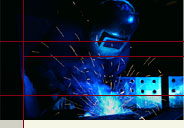
Warning: Do not turn up the boost pressure unless supporting mods are in place. At the very minimum, an aftermarket free-flowing cat-back exhaust and low restriction cone type air intake filter are needed. Even then, the boost should only be turned up a pound or two of psi over the stock level of 9.5 psi. Any higher than that and the ECU chip would need the fuel maps reprogrammed. This highest psi I would recommend on stock turbos with an aftermarket intake, exhaust, and chip would be 12-13 psi. Now would be a good time to refer to this site's Disclaimer.
Using only boost jets, I was having a hard time making over 10 psi of boost pressure after my new JWT 530 BB turbos were installed. I'm guessing this was because the wastegate springs on the new turbos were stronger. Regardless of the reason, I decided to try a manual boost controller I already had on the shelf. MY Z buddies were screaming at me to get an electronic boost controller (EBC) but I like trying the simplest solution first. Not to mention the EBC would run me several hundred dollars.
The same .030" boost jets that gave me 15 psi with my stock turbos would not get me over 10-11 psi with the JWT's. I even dropped down a size in boost jets to .026" but the boost pressure stayed the same. At that point, I decided to try an old Hallman manual boost controller (MBC) that I had sitting on my shelf for years.
I take a SBE (Simple But Effective) approach to most mods on my car. I had been happy for years with my boost jets, which was the most basic form of boost control. By sticking with a MBC, I did not have to deal with any electrical wires, splicing, behind dash work, cutting, programming, and no cash outlay was needed. The only parts I needed to buy were some plastic T connectors for the vacuum lines (or boost lines, depending upon how you look at it).
The next pic is of the most basic Hallman ES manual boost controller, that sells for $75 before any discounts. I had bought this years ago on eBay.
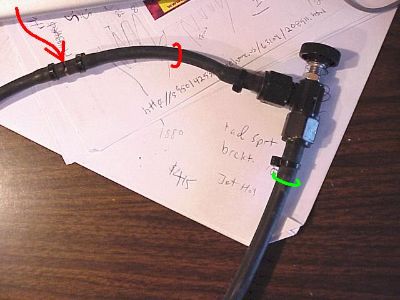 The line circled in red was labeled "To Wastegate." The green line was labeled "To Boost Source," which in this case were the nipples on the intercooler hardpipes, shown below. The line circled in red was labeled "To Wastegate." The green line was labeled "To Boost Source," which in this case were the nipples on the intercooler hardpipes, shown below.
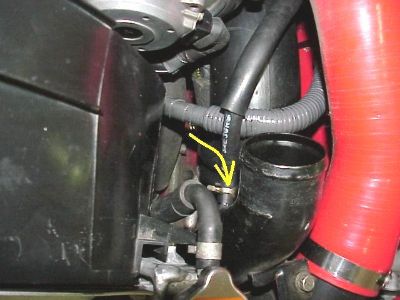 This is the passenger side wastegate hose connected to the black intercooler hardpipe. The large, inner, bright red silicone intercooler hose has been removed for access. This is the passenger side wastegate hose connected to the black intercooler hardpipe. The large, inner, bright red silicone intercooler hose has been removed for access.
In the above pic, the fan shroud is to the left, and the radiator cap can be seen peeking up at the bottom middle edge. There is a passenger side wastegate hose also. I had to remove both red intercooler hoses on the passenger side to access the wastegate hose. My red hoses are aftermarket. The stock boost hoses were black with insulating sleeves.
Look at my Boost Jets write-up for a more detailed description of the location of the wastegate lines and the hardline nipples. This MBC was spliced into those connections. Since there are two turbos, and therefore two wastegate lines, the turbos' wastegate lines have to be T'd together with a plastic connector before being attached to the MBC.
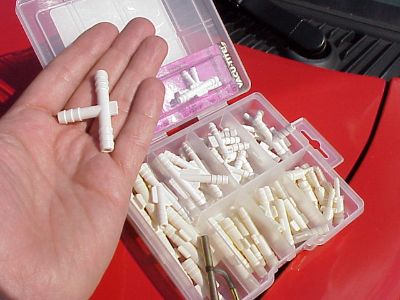 For a couple of bucks I could get two of the 1/4" X 1/4" X 1/4" "T" connectors in my hand, but for a few dollars more I bought the variety pack. For a couple of bucks I could get two of the 1/4" X 1/4" X 1/4" "T" connectors in my hand, but for a few dollars more I bought the variety pack.
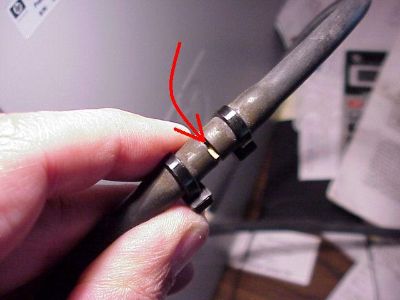 This brass fitting came already spliced into the MBC's wastegate line. The arrow points to a small hole open to atmosphere. This brass fitting came already spliced into the MBC's wastegate line. The arrow points to a small hole open to atmosphere.
I did not understand the purpose of this hole but the directions said to leave it in, for sure.
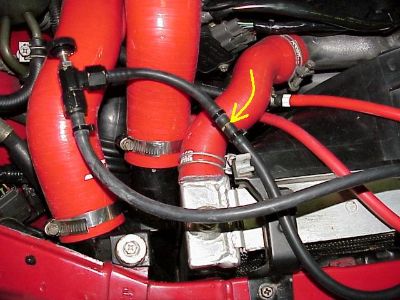 The yellow arrow shows the location of the above brass fitting, relative to the MBC. Same pic below with a wider angle. The yellow arrow shows the location of the above brass fitting, relative to the MBC. Same pic below with a wider angle.
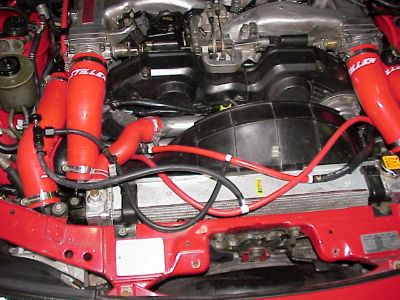 This was the temporary install I used while making WOT boost runs in 2nd and 3rd gears. The adjustment knob on the MBC had a lock nut which I tightened after each run. This was the temporary install I used while making WOT boost runs in 2nd and 3rd gears. The adjustment knob on the MBC had a lock nut which I tightened after each run.
An aftermarket boost gauge was a must. I temporarily used this VDO boost gauge to set the psi on the MBC. The stock boost gauge is calibrated poorly, and many times will not read correctly at higher than stock boost levels.
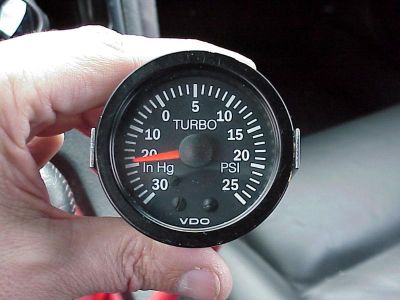 I did not permanently mount or install this VDO gauge. I prefer keeping my interior as stock appearing as possible. I did not permanently mount or install this VDO gauge. I prefer keeping my interior as stock appearing as possible.
For safety and so the driver can concentrate on the road, I recommend letting a passenger monitor the gauge while doing WOT (wide open throttle) runs to set the boost pressure.
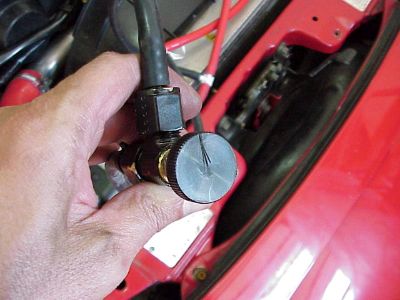 After boost pressure was set "close" to what I wanted, I scored the adjustment knob with a knife to keep track of very small turns in the wheel. After boost pressure was set "close" to what I wanted, I scored the adjustment knob with a knife to keep track of very small turns in the wheel.
Tightening or turning the wheel clockwise increased the boost. Counterclockwise decreased the boost. Once I had the knob 'within range," a quarter turn of the wheel roughly changed the boost by half a pound psi.
Yes, I had to get out of the car each time after each run to adjust the knob. I had the boost pressure set where I wanted after eight runs. I accomplished the whole procedure on a two-mile stretch of hightway. Be very careful when you pull over.
I have been arguing this point with a couple of my Z buddies. I say it does NOT matter if the wastegate hoses leading to the MBC are the same length or not. As long as there was a common hose to both wastegates, I can splice the MBC into that common hose anywhere along its length. The two turbos are not going to be able to tell the difference between a one foot or six foot piece of wastegate vacuum hose during turbo spool up. Also, I say that the boost source hose coming from the MBC does NOT have to be split and T'd back into the engine at two separate connections, that a single hose connection from the MBC to just one of the black intercooler hoses would be fine, even with a twin turbo.
So once I had the MBC set, I tightened the lock nut so the wheel would not turn, and did a cleaner install with different length tubing.
| 